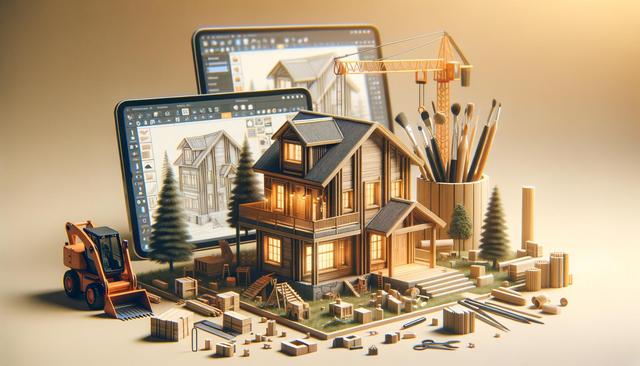Understanding the Role of Construction Software
Construction software plays a vital role in modern infrastructure development by streamlining multiple stages of the building process. From initial design through to final project delivery, these digital tools help construction professionals improve efficiency, reduce errors, and enhance collaboration. One prominent category within this ecosystem is 3D building design software, which allows architects and engineers to model structures in three dimensions before a single brick is laid. This not only ensures greater design accuracy but also helps identify potential structural or design issues early on. As a result, project teams can make better-informed decisions, reduce rework, and stay aligned with project timelines and budgets.
Incorporating construction software into daily workflows leads to better communication among stakeholders. Teams can share real-time updates, access centralized documentation, and coordinate tasks seamlessly. This digital integration reduces the reliance on paper-based processes and minimizes the chances of miscommunication or data loss. Furthermore, many platforms now offer cloud-based solutions, enabling remote access and collaboration—an increasingly valuable feature in today’s hybrid work environments.
Key Features of 3D Building Design Software
3D building design software offers a suite of tools that bring architectural and engineering concepts to life with visual clarity. These platforms provide detailed modeling capabilities that go beyond traditional 2D blueprints, giving users the ability to simulate real-world conditions, test structural integrity, and visualize interiors and exteriors alike. Such capabilities are essential for both client presentations and internal planning processes.
Some notable features often found in 3D building design software include:
- Parametric modeling for easy design adjustments
- Integration with Building Information Modeling (BIM) systems
- Rendering tools for realistic visualization
- Clash detection to identify design conflicts
- Cost estimation and material takeoff modules
These tools not only enhance the design phase but also support construction and maintenance planning. By integrating with other construction software systems, such as project management or scheduling tools, the design data becomes part of a larger, interconnected workflow that supports the entire building lifecycle.
Benefits for Project Planning and Management
Construction software contributes significantly to the planning and management stages of building projects. It allows project managers to allocate resources more effectively, track progress against schedules, and ensure compliance with regulatory standards. This is particularly valuable for large-scale builds where coordination across multiple teams and subcontractors is critical.
Among the most appreciated benefits are:
- Improved budget control through real-time cost tracking
- Enhanced scheduling with timeline visualization tools
- Risk management support through predictive analytics
- Streamlined documentation and reporting
When used alongside 3D building design software, these planning tools create a cohesive system where design changes automatically update associated schedules and cost estimates. This level of integration can reduce delays and help maintain project momentum, even when unexpected challenges arise.
Enhancing Collaboration Across Teams
Effective collaboration is essential in construction, where multiple disciplines must work in unison to achieve a shared vision. Construction software fosters this collaboration by providing a central platform where all stakeholders can contribute and stay informed. From designers and engineers to contractors and clients, everyone benefits from having access to the same up-to-date information.
3D building design software enhances this process by offering visual representations that are easy to understand, even for non-technical team members. This transparency promotes clearer communication and enables faster decision-making. Features such as version control and change tracking ensure accountability and make it easier to review project history or revert to earlier designs when necessary.
Moreover, many platforms support integration with communication tools and mobile applications, allowing on-site teams to report progress, raise issues, or consult designs directly from their devices. This real-time exchange of information reduces bottlenecks and improves overall workflow efficiency.
Trends Shaping the Future of Construction Software
The construction industry continues to evolve, and software tools are adapting to meet new demands. Emerging technologies such as artificial intelligence (AI), machine learning, and augmented reality (AR) are beginning to integrate with construction software platforms. These advancements promise even more powerful capabilities, from automating routine tasks to enhancing safety protocols through immersive training simulations.
In the realm of 3D building design software, we are seeing:
- Greater use of generative design to explore multiple design solutions
- Increased reliance on cloud collaboration for distributed teams
- Integration with IoT devices for real-time data inputs
- Enhanced sustainability modeling to support green building initiatives
These innovations are not only making the construction process more efficient but also contributing to more sustainable and resilient infrastructure. As construction software continues to evolve, professionals who embrace these tools will be better positioned to deliver high-quality projects that meet the needs of modern communities.
Conclusion: Embracing Digital Tools for Smarter Construction
For professionals in architecture, engineering, and construction, adopting construction software—particularly 3D building design software—offers a clear path to greater efficiency, collaboration, and innovation. These tools empower teams to visualize outcomes, coordinate more effectively, and manage projects with precision. As the industry continues to digitize, staying informed and adaptable will be essential to maintaining a competitive edge. By integrating these technologies into everyday processes, builders and designers can meet the increasing demands of complex projects while delivering high standards of quality and accountability.












